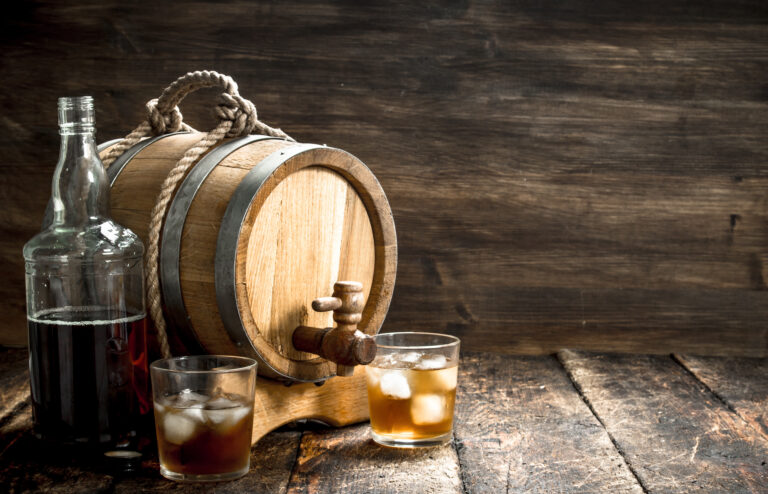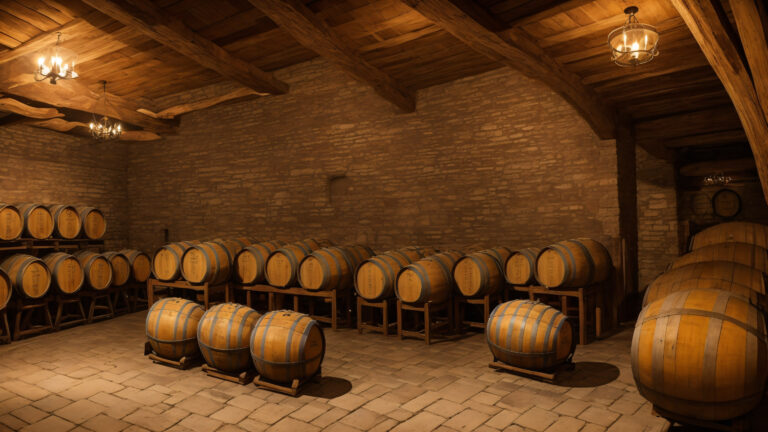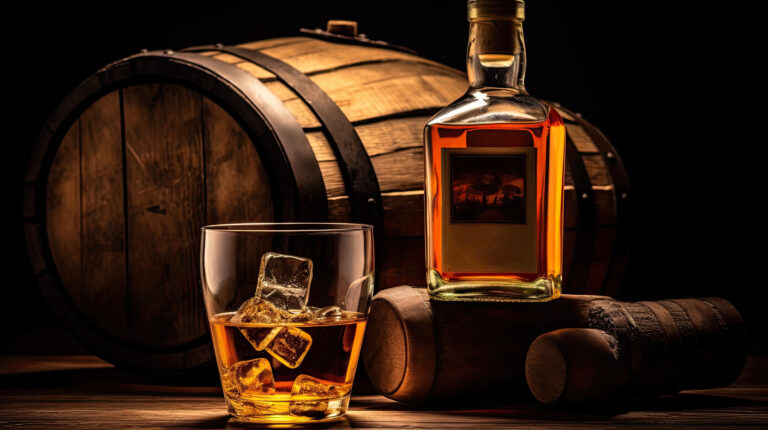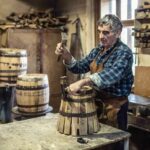Ever wondered why your favorite whiskey tastes so darn good? Sure, the blend of grains and yeasts kick things off, but the real star of the show, the unsung hero that gives whiskey its signature swagger, is barrel aging. This magical process, often called barrel fermentation (though technically it’s aging, not fermentation), is what transforms a harsh, fiery spirit into the smooth, complex, amber liquid we all know and adore.
As a whiskey newbie, you’ve probably heard terms like “single malt” or “small batch,” but barrel aging is where the genuine alchemy happens. Picture this: the inside of those oak barrels is intentionally charred, which caramelizes the wood’s natural sugars and unlocks its hidden tannins. Over months, even years, the whiskey slowly breathes in these flavors from the wood, softening its edges and amplifying its character. The longer it rests, the more intricate and delightful those flavors become.
What Is Barrel Aging (or Fermentation)?
Barrel aging is essentially the art of letting distilled spirits like whiskey mature in wooden barrels. As the whiskey hangs out in these casks, it soaks up incredible flavors from the wood and undergoes fascinating chemical changes that give aged whiskey its unmistakable taste.
Most commonly, these crucial whiskey barrels are crafted from American white oak or European oak. They’re usually charred on the inside – this isn’t just for show; it seriously boosts the whiskey’s ability to absorb flavor from the wood. And as the whiskey gracefully ages in these barrels, a little bit of it evaporates – we lovingly call this the “angel’s share.” What’s left behind? A liquid infused with notes of vanilla, caramel, and a hint of spice from the wood.
- American white oak barrels are known for lending sweeter, more vanilla-forward notes.
- European oak barrels tend to contribute more robust, spicy flavors.
Generally, the longer a whiskey ages, the more complex its flavor profile becomes. Many premium whiskeys spend a decade or even two (or more!) in barrels to develop truly intricate flavors. However, aging time isn’t the only player here; the specific barrel, the surrounding environment (think temperature and humidity!), and the distilling techniques themselves all have a massive impact on the final flavor.
Barrel aging is truly an art form, a point of immense pride for many distillers. The sheer variety of flavors that can emerge from the simple dance between distilled spirit and wood is astonishing. For whiskey connoisseurs, delving into how different barrels and aging processes influence flavor is a lifelong adventure. If you’re just dipping your toes into the world of whiskey, understanding barrel aging is a truly fascinating starting point.
The Indispensable Role of Wood in Whiskey Production
The wood used to craft whiskey barrels is an absolute game-changer in developing the flavor of the final product. Oak barrels have been the go-to choice for centuries, consistently imparting those lovely vanilla and caramel notes as the whiskey intimately interacts with the wood.
The Aging Process: A Slow Dance with Oak
As whiskey patiently ages in oak barrels, it absorbs compounds from the wood that fundamentally alter its flavor. The longer it ages, the more layers of complexity it develops. Many distilleries strategically choose specific oak types based on the exact flavor profiles they’re aiming to achieve.
- American oak often delivers richer vanilla and coconut flavors thanks to its higher levels of lactones.
- French oak tends to contribute subtle spice and nutty flavors from compounds like eugenol and vanillin.
The barrels are typically charred on the inside, which doesn’t just add flavor; it also helps to filter and mellow the whiskey. As it ages, the whiskey expands and contracts with changes in temperature, gently moving in and out of the wood’s grain. This constant interaction extracts essential compounds like oak lactones, tannins, and phenols that contribute both color and flavor.
The Finished Product: A Symphony of Flavors
When finally deemed ready, the whiskey will have developed a beautiful balance of flavors, including delightful hints of vanilla, caramel, and oak, alongside the natural grain flavors of the original distillate. The precise aging time is a careful decision, depending on the type of whiskey and the desired flavor profile.
Through the meticulous selection of oak barrels and the skillful management of the aging process, distillers are able to craft a whiskey that’s as unique and nuanced as a fine wine. The next time you take a thoughtful sip of bourbon or Scotch, take a moment to truly appreciate the subtle flavors gifted by the wood – without it, whiskey as we know it simply wouldn’t exist.
How Barrels Impart Flavor During Aging
Barrel aging is truly the cornerstone for developing the iconic flavors of bourbon and other whiskeys. As the spirit rests within those charred oak barrels, it gradually absorbs compounds from the wood that bestow delightful notes of vanilla, caramel, and spice. And yes, the longer a whiskey ages, the more wonderfully complex its flavor profile becomes.
Charring the Barrels: The Flavor Catalyst
Before they’re filled with precious whiskey, barrels undergo a crucial step: they’re toasted and charred. This charring process doesn’t just blacken the wood; it literally caramelizes the wood’s natural sugars and opens up its grain, allowing the whiskey to really penetrate deep into the barrel. The char also acts as a natural filter, effectively mellowing the whiskey by absorbing harsh compounds. The level of char is a big deal – a darker char generally means a more robust flavor imparted to the whiskey.
Extracting Flavor from the Barrels: A Slow Infusion
As whiskey patiently ages in the barrels, it steadily extracts flavorful compounds from the wood, including vanillin (hello, vanilla!), lactones (think buttery coconut!), and tannins (a hint of dryness and structure). These compounds slowly seep into the whiskey, imbuing it with those coveted notes of vanilla, butterscotch, and oak. The whiskey also draws its beautiful warm, amber hue from the barrel. Even environmental factors like temperature, humidity, and even the local weather influence how quickly the whiskey absorbs these flavors. Interestingly, colder, drier climates can sometimes accelerate whiskey aging.
Evaporation and the Angel’s Share: A Necessary Sacrifice
While nestled in its barrel, a portion of the whiskey inevitably evaporates – this is what we affectionately call the “angel’s share.” On average, about 2-4% of the whiskey in a barrel says goodbye each year. While it might seem like a loss, this evaporation actually helps to concentrate the flavor in the remaining liquid. After several years, the angel’s share can account for a significant amount, sometimes 50-70% of the original whiskey volume! But despite this sacrifice, the remaining whiskey develops an unparalleled richness and complexity.
Blending Barrels: The Master Distiller’s Art
Master distillers are like watchful guardians, carefully monitoring barrels as they age, regularly tasting samples to determine when the whiskey has reached its peak maturity and flavor. They then skillfully blend whiskey from select barrels to create a perfectly balanced, consistent product. This art of barrel selection and blending plays a absolutely vital role in producing a premium, distinctively flavored whiskey.
Factors That Influence Barrel Aging
The barrel aging process is absolutely critical to developing the distinctive flavor and aroma profiles of whiskeys. Several key factors profoundly influence how barrels impact the whiskey during its maturation journey.
Barrel Type: The Foundation of Flavor
The type of barrel used, almost always oak, has a monumental effect. American white oak barrels are a favorite for bourbon, imparting lovely vanilla and coconut notes. European oak barrels, on the other hand, tend to produce more spicy, smoky flavors often found in Scotch whiskies. Even the barrel’s previous use matters; used barrels (often called “second-fill”) typically produce subtler flavors than brand-new ones.
Barrel Toast and Char: Depth of Character
Lightly toasting or heavily charring the inside of barrels isn’t just for looks; it helps develop incredibly complex aromas. The level of toasting or char dictates how much the wood’s natural compounds break down into desirable flavors like caramel, chocolate, and coffee. More heavily charred barrels will impart darker, roasted notes to the whiskey.
Barrel Size: Surface Area Matters
The amount of surface area in contact with the whiskey directly impacts how quickly it absorbs flavors and colors. Smaller barrels mean a greater proportion of wood exposure relative to the whiskey volume, which accelerates maturation. Many craft distillers leverage smaller barrels to create flavorful whiskeys in less time.
Environmental Factors: Nature’s Influence
Temperature and humidity are also major players in maturation. Warmer temperatures tend to speed up the chemical reactions within the barrel, while cooler temperatures slow them down. More humid conditions can help the barrel staves swell, tightening them and preventing excessive oxidation. Even the specific location of the rickhouse (the warehouse where barrels are stored), which might be exposed to coastal breezes or mountain air, can subtly alter the whiskey’s aroma compounds.
Maturation Duration: The Test of Time
The length of time a whiskey ages in the barrel directly correlates to how much flavor, aroma, and color it absorbs. Young whiskeys, aged for just a few years, often taste more grainy, while decades-old whiskeys become incredibly smooth and oak-forward. Many distillers expertly blend whiskeys of different ages to achieve a desired balance of fresh and aged flavors.
With the right combination of these factors, distillers can craft an astonishing array of whiskeys as diverse and complex as the wood itself. The humble barrel truly elevates whiskey into an art form.
Common Woods Used for Whiskey Barrels
The wood used to craft whiskey barrels has an enormous impact on the flavor and aroma of the final product. Here are a few types of wood commonly employed:
Oak: The Reigning King
By far the most popular choice, oak barrels consistently impart that distinctive vanilla and caramel character to the whiskey. Within oak, two main varieties are predominantly used:
- American white oak typically offers a sweeter, lighter flavor with delightful notes of coconut and spice. By law, bourbon must be aged in new charred American white oak barrels.
- European oak, like French oak, contributes subtle flavors of clove and nutmeg. Sherry and port casks made of European oak are frequently used to age single malt Scotch whisky, adding incredible depth.
Maple: A Sweet Diversion
Maple wood barrels can lead to a whiskey with intriguing hints of maple syrup, nuts, and toast. Though less common, some craft distilleries in North America use maple for a truly unique flavor profile.
Hickory: The Smoky Enigma
Hickory wood is renowned for imparting a distinctly smoky, even bacon-like flavor to whiskey. It’s an unusual choice, but it can create an intensely savory spirit. Some experimental craft distillers have ventured into using hickory barrels to age their whiskey.
Chestnut: The Honeyed Touch
Chestnut barrels tend to mellow and sweeten the flavor of the whiskey, imparting aromas of honey and spice. Like maple and hickory, chestnut is an uncommon choice but is slowly gaining interest among innovative craft distilleries.
Ultimately, the specific wood type, the barrel’s previous use, how long the whiskey ages, and other crucial factors all converge to determine the complex flavors of the final product in your glass. Exploring different whiskeys aged in different types of barrels is a fantastic way to discover the incredible variety of flavors that wood has to offer.
The Maturation Process Inside the Barrel: A Chemical Ballet
The maturation process is where the true magic of whiskey making unfolds. Once the distilled spirit has been carefully placed in charred oak barrels, a series of complex chemical reactions begin, ultimately giving aged whiskey its distinctive aroma, flavor, and color.
Evaporation and the Angel’s Share: A Heavenly Contribution
As the whiskey rests in the barrel, some of the liquid will inevitably evaporate. This is famously known as the “angel’s share” – the portion of whiskey that gently disappears from the barrel during maturation. This angel’s share typically amounts to between 2-4% of the barrel’s volume each year. While it might seem like a loss, this evaporation actually helps to concentrate the flavor and aroma compounds in the remaining liquid, making it even more intense and delicious.
Absorption of Flavors and Aromas: Wood’s Embrace
The whiskey eagerly absorbs many of the barrel’s characteristics, like the oak’s natural vanilla and caramel flavors. The charred interior of the barrel also imparts that wonderful smoky flavor. As time passes, additional delightful aromas of dried fruit, nuts, and warm spices emerge. And, of course, the whiskey takes on its rich golden amber hue directly from the wood.
Oxidation: Mellowing with Air
As oxygen gently interacts with the whiskey during maturation, it works to mellow the spirit and create even more complex flavors. Older, harsher compounds break down while exciting new ones form, resulting in a significantly smoother, more full-bodied taste.
The barrel aging process demands patience, but it’s undeniably worth the wait. Just two, three, or even four years of maturation in quality oak barrels can create a superb, well-rounded whiskey. While technology has certainly accelerated some aspects of spirits production, quality whiskey still relies heavily on traditional barrel aging to achieve its distinctive flavor. There are simply no shortcuts to crafting a truly great whiskey.
How Long Should Whiskey Be Barrel Aged?
The ideal aging time for whiskey is largely a matter of the type of whiskey and, ultimately, personal taste. This aging process, often called barrel aging or sometimes referred to as barrel fermentation, allows the whiskey to soak up flavors and aromas from the charred oak barrel. Generally, the longer it ages, the more complex its flavor and aroma profile becomes.
Bourbon: By Law, a Minimum
By law, bourbon must be aged for at least two years to legally be called bourbon. Many bourbons are aged three to five years, which typically produces a lovely balance of oak and caramel flavors. If you’re looking for a more smoky, spicy bourbon, consider one aged six years or even longer.
Tennessee Whiskey: Charcoal-Filtered Character
Tennessee whiskey like Jack Daniel’s is usually aged for four to six years, which gives it its signature mellow, charcoal-filtered character. Older versions, like Gentleman Jack, are aged longer for added complexity.
Scotch Whisky: A Longer Journey
Scotch whisky typically enjoys a longer aging period than American whiskeys. Aging for eight to twelve years often yields a smooth, fruity single malt. Twelve years and older can produce a more robust, nutty whisky with delightful sherry or fruit notes. Some highly prized Scotches are aged for twenty years or more, resulting in an ultra-smooth, luxurious sipper.
Rye Whiskey: Spice with a Softer Side
Rye whiskey usually ages around two to four years. Aging longer, up to six or eight years, helps to mellow the spicy, peppery flavors inherent in the rye grain. However, rye can sometimes lose some of its distinctive character the longer it ages compared to other whiskeys.
Ultimately, aging whiskey is a true art form. Distillers meticulously monitor barrels, tasting samples to pinpoint exactly when the whiskey has reached its peak flavor and aroma. For the home enthusiast, your own personal taste preferences are the ultimate guide for how long a barrel-aged whiskey “should” be aged. The choices are abundant, so dive in, explore the options, and discover your perfect sweet spot.
New Oak vs. Used Barrels: A Balancing Act
When it comes to aging whiskey, distillers face an important choice: new oak barrels or used barrels. Each option comes with its own set of pros and cons, heavily influencing the flavor profile and aroma the distiller aims to achieve.
New Oak Barrels: Bold and Flavorful
New oak barrels impart a much more pronounced oak flavor to the whiskey. Since the wood is fresh, it readily releases oak lactones and tannins, giving the whiskey its distinctive vanilla aroma and a spicy, woody taste. Bourbon, for example, is legally required to be aged in new charred oak barrels. The charring process here is key; it caramelizes the wood sugars and gives bourbon its signature rich brown color and delightful sweet, smoky flavor.
However, new oak barrels are generally more expensive and, from an environmental perspective, less sustainable since more trees need to be cut down. They also have the potential to overpower the natural flavor of the distillate if the whiskey is left in them for too long. Many distillers wisely use a mix of new and used barrels to find that perfect balance between oakiness and the distillate’s natural characteristics.
Used Barrels: Subtle and Sustainable
Used barrels, often sourced from bourbon distilleries, have already gone through one aging cycle, so they impart more subtle oak notes. This allows the natural flavor of the distillate to truly shine through, often resulting in a whiskey with fruitier, maltier notes. Used barrels are also a more sustainable and cost-effective choice.
However, used barrels may have absorbed flavors from their previous contents that can carry over to the new distillate, which can be a pro or a con depending on the desired outcome. They also tend to provide less color to the whiskey. Some distillers opt to re-char used barrels to bring back more oak character before refilling them, creating an interesting intermediate effect.
Ultimately, the choice of barrel type boils down to the distiller’s vision for the final whiskey. By experimenting with different barrels, distillers can craft a wide spectrum of flavored whiskeys to suit nearly every taste. The barrel’s role in aging whiskey is truly as much an art as it is a science.
The Future of Barrel Aging and Whiskey Innovation
The whiskey industry is a dynamic and constantly evolving space. As demand for craft and premium spirits continues to soar, distillers are fearlessly experimenting with diverse barrel types, sizes, and aging techniques to produce innovative new flavors that push the boundaries of what whiskey can be.
Alternative Barrels: Expanding the Palate
Distillers are increasingly aging whiskey in barrels made from different woods, such as maple, hickory, and cherry. These unique wood types impart distinctive flavor notes to the whiskey. Some are even venturing into using barrels that previously aged other spirits like rum, brandy, or wine, creating truly unique and exciting flavor profiles.
Barrel Finishing: A Second Act for Flavor
A growing trend is “barrel finishing,” where distillers transfer whiskey to different barrels for a final flourish to enhance and intensify flavors. They’ll age the whiskey for a period in traditional charred oak barrels, then move it to barrels that previously held port, sherry, or wine for an additional period. The whiskey then absorbs new layers of flavors and aromas from this second barrel, resulting in a wonderfully complex, layered taste.
Small Barrels: Accelerated Evolution
Aging whiskey in smaller barrels, typically ranging from 5 to 30 gallons, can significantly accelerate the aging process. The increased surface area to volume ratio means more of the whiskey is exposed to the wood, allowing flavors to be imparted much faster. However, there’s a trade-off: the whiskey can become “over-oaked” more quickly. Some distillers strategically start whiskey in small barrels and then transfer it to larger ones to finish aging, achieving a balanced profile.
Blending and Bottling: Crafting the Masterpiece
Master blenders are the artists who combine whiskeys of different ages, barrel types, and finishing techniques to create innovative blends with truly unique flavor profiles. They may also bottle and label single barrel or small batch whiskeys to highlight particularly distinctive tastes from individual barrels.
The future of barrel-aged whiskey looks incredibly promising, with no shortage of creativity. Distillers worldwide are crafting premium, innovative spirits to satisfy the evolving tastes of whiskey connoisseurs everywhere. The vast range of woods, barrel sizes, aging methods, and blending techniques promises an exciting landscape of new flavors for whiskey lovers to savor and enjoy.
Cheers to the future of barrel aging and whiskey innovation!
Final Thoughts
So there you have it – the lowdown on how barrel aging works its incredible magic in the whiskey making process. While the intricacies of wood types, char levels, and aging times can get quite complex, the fundamental idea is beautifully simple. Placing distilled spirits in wooden barrels allows the liquid to breathe and interact with the wood, meticulously extracting the flavors and colors that create the distinctive taste of barrel-aged whiskey. The next time you slowly sip a glass of fine whiskey, you’ll undoubtedly have a deeper appreciation for the immense time, care, and craftsmanship that went into its creation. Barrel aging is truly an art form, and the end result is something meant to be slowly enjoyed and savored.







